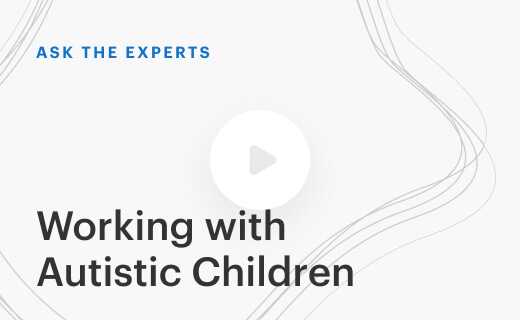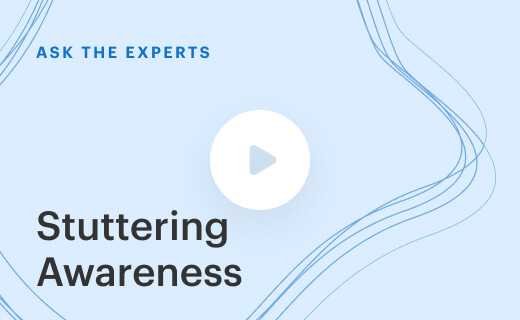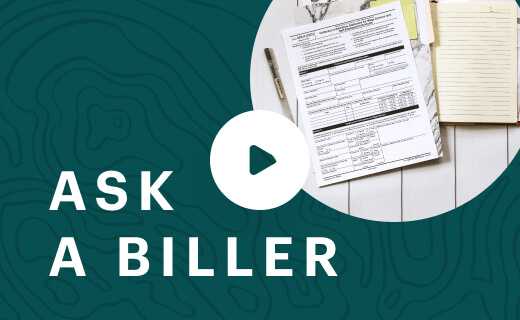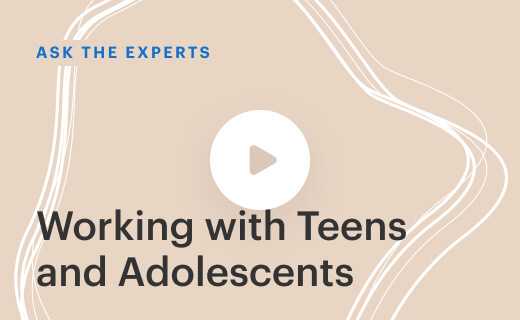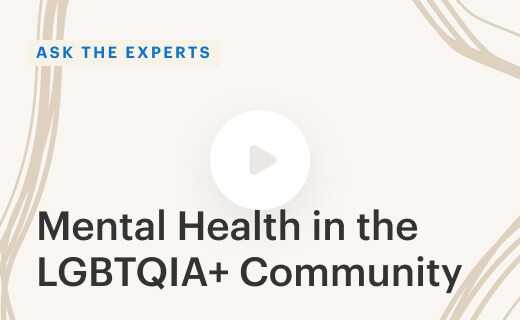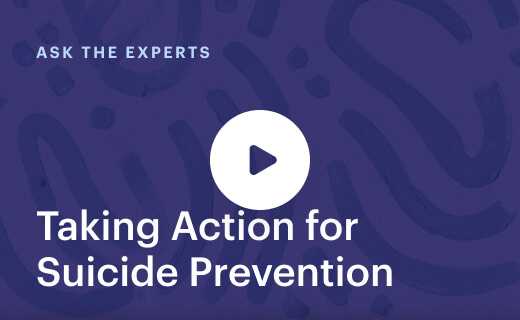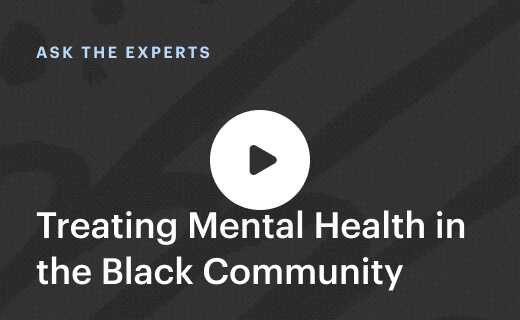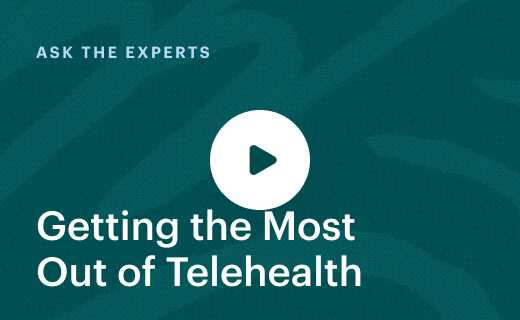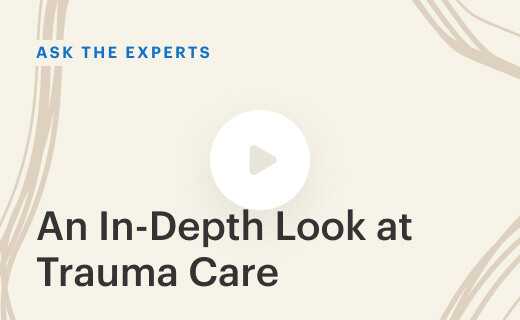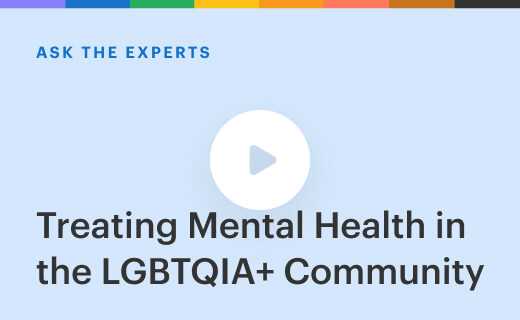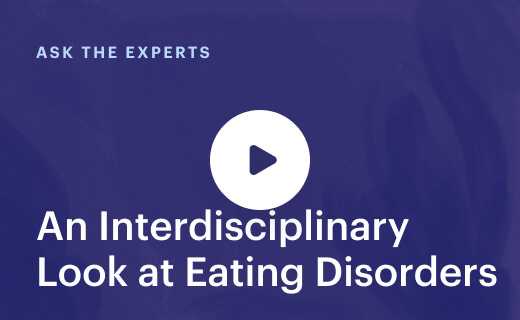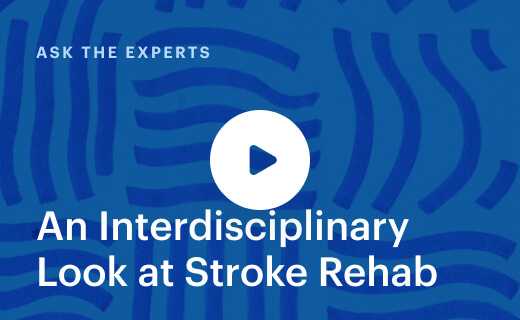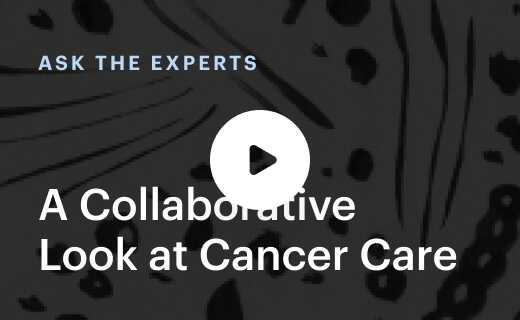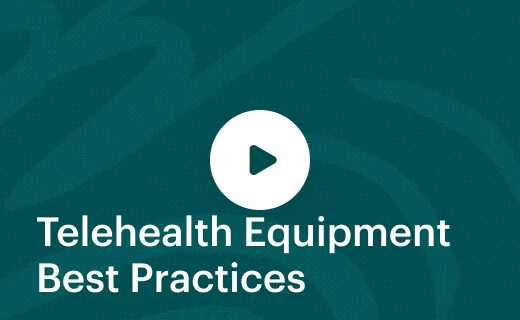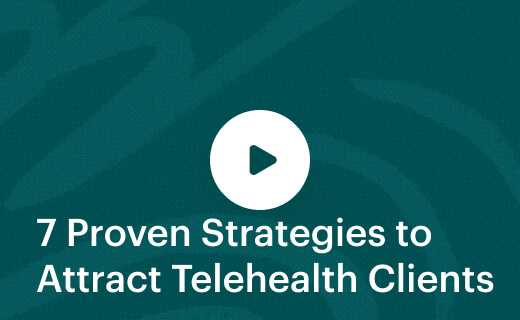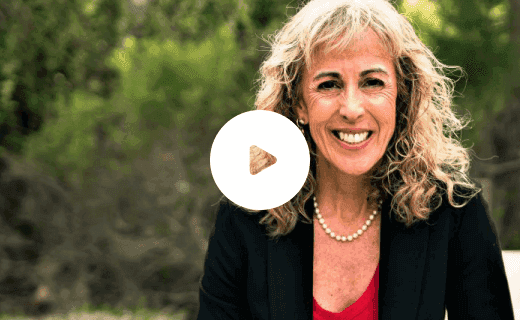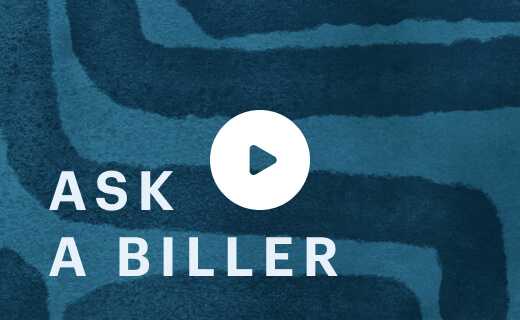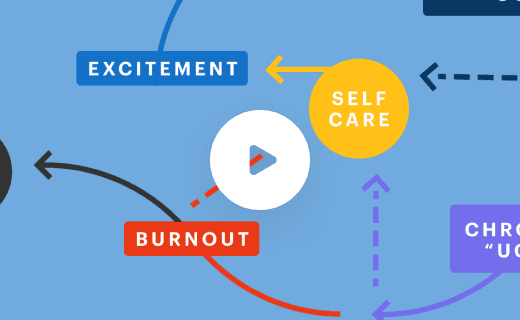Treating Mental Health in the LGBTQIA+ Community
Free 30-day trial, access all this & more:
Want to know about other great webinars?
Join Dr. Yamonte Cooper, Nina Firooz, LMFT, and Cadyn Cathers, PsyD as they discuss what it’s like to work with individuals who identify as part of LGBTQIA+ community.
Moderated by Dominique Zumwalt, the Director of Creative Marketing at SimplePractice, this group of experts offer insight and background into their own line of work, and what brought them to the panel to speak about working with clients in the LGBTQIA+ community. They discuss everything from treating the mental health of intersectional clients, barriers somebody might face due to religion, and best practices for a client undergoing gender reassignment surgery.
In addition, they offer advice on how you can stay educated and up-to-date with different care methods when treating mental health in the LGBTQIA+ community. They also give insight on how you can work with clients even if you don’t personally identify as LGBTQIA+.
- Introductions
- What does each letter of LGBTQIA+ mean?
- What discussions do you want clinicians to be having more often regarding LGBTQIA+ clients especially queer and trans people of color?
- How can you help someone that’s unsure of their sexual identity?
- How do I support a client who struggles with same-sex attraction but doesn’t want to come out because of religious beliefs?
- In your experience, what is the most common barrier for the LGBTQIA+ clients in working with a therapist who doesn’t identify as such?
- Are there best practices when addressing issues of intersectional clients in therapy for example, black and gay, LatinX and trans?
- What do therapists need to know about gender reassignment surgery and what needs to be included in our letters for our clients?
- After a client has had a gender confirming surgery, what kind of role does the therapist play during that recovery period?
- How do you tease out when you’re unconsciously putting the responsibility on your clients to teach you about their experience versus having them discuss their experiences to explore therapeutically?
- Can you speak to the benefits of a sex certification, particularly when working with LGBTQIA+ populations?
- What last minute things that any of you would like to speak to or to mention to our audience?
1. Introductions
Dominique Zumwalt: Hello everyone, and welcome to today’s webinar, Ask The Experts Treating Mental Health in the LGBTQIA+ Community. I am Dominique Zumwalt. I’m on the marketing team here at SimplePractice. I’m also today’s facilitator. Before we get started, I have a couple of housekeeping things I’d like to go over. This webinar will be recorded so all registrants will receive an email with the recording. So keep an eye in your inbox. You’ll probably get that sometime tomorrow.
Also, if you navigate to the go to webinar control panel, under the handouts tab you’ll see a downloadable PDF that includes all of today’s slides. Please feel free to look ahead at all the pre-submitted questions we’ll be asking our experts today. We’re probably not going to be able to get to all of these questions, just given the time constraints but if you see anything that hasn’t already yet been asked, please feel free to go to the control panel under the questions tab and submit any questions that you would like to pose to our experts here today.
We’ll also be using the remaining of our time—probably the last 10 minutes or s—to answer as many live questions as we can get to. So without any further ado, let’s jump right in. First, I would like to introduce Dr. Yamonte Cooper. Thank you for being with us today. Tell us a little bit about yourself and your motivation for being here today.
Dr. Yamonte Cooper: Sure. I am counseling faculty at a local community college and I am adjunct faculty at a local university and I am in private practice as well. And my motivation for being here today is really to speak to the experiences of black LGBTQ+ folks and also speak to folks of color and their experiences as well.
Dominique Zumwalt: Excellent. Thank you. Next, I would like to introduce Nina Firooz. Please tell us a little bit about yourself and your motivation for being here today.
Nina Firooz: Sure. Hi, I’m Nina. Nice to meet everyone. My pronouns are she, her and hers. I am in full-time private practice and my practice is centered around the experiences of LGBTQ adults. I have three main focuses in my private practice. One of them is working with both black and non-black POC who are members of the queer and trans communities.
And then I also spent a majority of my therapeutic career working in drug and alcohol treatment specifically focusing on the needs of LGBTQ folks in recovery. And the other specialty that I have is working with LGBTQ folks who are reconciling faith and sexuality, faith in gender, contending with religious transphobia, religious homophobia, religious bi-phobia and working on spiritual pain in regards to that.
Dominique Zumwalt: Thank you, Nina. And your motivation for being here today?
Nina Firooz: Thank you. Yes. It’s a good question. My motivation for being here today is to speak alongside my fellow panelists who we each have our own experiences as we embody different intersecting identities. And so for me, part of it is being a queer woman in this space and being a non-black person of color in this space and just bringing some of my experience to folks who’ve registered because they’re showing a genuine interest in how do I provide better services to the people who are in my community? And that’s really important to me. So that’s why I’m here.
Dominique Zumwalt: Thank you for being here. And last but not least, Cadyn Cathers. Please tell us a little bit about your work, what you do and your motivation for being here today.
Cadyn Cathers: I wear a lot of hats. So I am the executive director of the Affirmative Couch, where we provide online continuing education for psychologists about working with LGBTQIA, consensually and non-monogamous, kinky clients of the gamut. I’m also affiliate faculty in the LGBT Specialization at Antioch University Los Angeles. And I’m a psych assistant in private practice, supervised by Kenneth Scott. And I focus on psychoanalytic psychotherapy specifically with transgender and gender non-binary groups. I’m really passionate about teaching and education around particularly transgender affirmative psychotherapy.
But LGBT affirmative psychotherapy in general because I don’t think that there’s nearly enough training, particularly at our programs in master’s and doctorate programs around how to work not just be friendly and open to actually work well and work affirmatively and to celebrate the diversity that LGBTQIA and LGBTQIA with intersectionality. So people of color, LGBTQIA people with disabilities, immigrants and all of those combinations working on how to work well. There’s not enough education. So that’s part of the reason I’m here as well.
Dominique Zumwalt: Excellent. Thank you so much. And thank you all again for being here today. Before we dive in, I do have one thing that I wanted to mention. Today’s pre submitted questions, they were submitted by registrant’s and we intentionally left them as is. We believed it was important to keep the entirety of the question intact because the way a question is asked contains many nuances and layers. So we wanted to make sure we honored that. And with that said, let’s start with our first question. First question is what does each letter of LGBTQIA+ mean? I know you can all speak to this but I’d like to start with Cadyn, then Yamonte then Nina.
2. What does each letter of LGBTQIA+ mean?
Cadyn Cathers: So we have lesbian, gay, bisexual, transgender, queer, intersex and asexual or aromantic. And one of the things about the B that needs to be noted is that B often is also used as Bi+ to include pansexual, panromantic and other non-model sexual identities. Trans can also be expanded to be trans and gender nonconforming as well as including two-spirit identities as well. And the plus is because the acronym keeps growing and growing and there are more identities that may not be included with all of those umbrella letters.
Dominique Zumwalt: Is there anything you wanted to add Yamonte or Nina?
Dr. Yamonte Cooper: I would just add that it’s important to understand that these are very distinct populations under the same umbrella. And so it’s important to understand that these are very distinct populations and not a homogeneous population. And I think people often are mistaken about that.
Nina Firooz: The thing that I would add too is this is something that can be Googled. You do not need to ask experts about this. For anyone who’s joining, I really want to empower each and every one of you to ask yourself before you ask someone else, “Can I Google this? Can I Yahoo this or whatever? Can I just look this up on my own? Am I feeling helpless because I don’t know and I’m scared to make a mistake?” Spoiler alert. Yes, you will make a mistake. And that’s okay. So yeah, you can Google it.
Dominique Zumwalt: Great. Thank you. Next question goes to Yamonte. What discussions do you want clinicians to be having more often regarding LGBTQIA+ clients especially queer and trans people of color?
3. What discussions do you want clinicians to be having more often regarding LGBTQIA+ clients especially queer and trans people of color?
Dr. Yamonte Cooper: Yes, there are so many. First, I would like to just say is that just like we talked about LGBTQIA+ being distinct populations, the acronym of POC is also an acronym that captures very distinct racialized minoritized populations who have different experiences in United States. So I think it’s very important to make that distinction. And so while I can talk about the experience of being a racialized minoritized person in United States, my experience is of a black person.
So it’s really important that people who identify as LatinX and Asian and Pacific Islander and Native American, First Nation folks, that they can speak to their unique experiences as well. The overlap is that I can talk about being racialized and minoritized. So I really want to make that distinction because that’s really important. One of the things that I would really draw attention to is what is called sexualized racism. And black and brown people typically have the experience of being sexually objectified and eroticized.
And so for black men specifically, they’re often looked at as a phallus and not a human being. And so that’s a problem that’s a common occurrence that happens within the LGBTQ+ community. Also sexualized racism looks like people posting ads for relationships or hookups and saying that “I’m not interested in black men and I’m not interested in Asian men.” With this idea that they’re not desirable. And so that’s another example of sexualized racism.
And these issues are very rampant in their community. So it’s very important to know about these things and to do your homework and learn about sexualized racism. The other thing that I would recommend would be that when you’re working with clients who are black and brown, that you address race in the room. And so often one of the big criticisms about therapists, specifically white therapists when it comes to black and brown clients who are LGBTQ+ is that they don’t address race and they adhere to this colorblind ideology racism that I don’t see color.
Well, we know that’s not true because if you believe that you would not have said that first of all and the research is showing that that’s not accurate. So addressing race in the room is very important. And also having an understanding of where someone’s relationship is with their racialized identity. And so what I have found often anecdotally is that white LGBTQ+ folks want black and brown people to let go of their racialized identity and adopt an LGBTQIA+ identity.
And that’s very problematic because you can’t do that. It’s part of your skin and your experience as soon as you step outside the door. And so that is really important to address. The other thing is that they include microaggressions and racism and case conceptualizations because it’s a very real experience. There’s research to support that. And I think we’re really seeing that now in society and we have the uprisings and the protest as a result.
Also integrating research findings and connection between discrimination experiences and psychological symptomology is really important. So again, integrating research findings between discrimination experiences and psychological symptomology is really important. There’s a lot of research on how discrimination affects health and health outcomes and lifespan and mortality. And also assessing and ameliorating potential negative scripts as a result of internalized microaggressions.
So it’s not uncommon for people who are oppressed, who are racialized and minoritized to internalize negative scripts about their value and who they are as people. Also including race and other intersecting identities in your case, conceptualization is really important. And also becoming familiar with people’s backgrounds. So their racial and ethnic identities doing research, taking classes, reading books and attending workshops.
What I find is that often people want quick solutions and quick answers and don’t really want to invest in the work. And if you are really serious about doing this work and it’s an investment. And it’s a lifelong investment that you don’t arrive at. The other thing that I would mention is that we’ve seen the dehumanization and the lynching and the executions of black people right now.
And so it’s important to really incorporate that in your work as well and also incorporate the dehumanization of black life. And also we see a proliferation of black working class men being lynched and executed and trans black women as well experiencing a lot of violence and death. And so those things have to be included in your case conceptualizations and the work that you do with your clients.
Dominique Zumwalt: Thank you so much. Our next question. This one is for Cadyn. How can you help someone that’s unsure of their sexual identity?
4. How can you help someone that’s unsure of their sexual identity?
Cadyn Cathers: So I’m going to expand this to just identity, right? So it might be sexual identity, it might be gender identity. And I think there’s a big part of it. Sometimes there’s going to be pressure from the client to be like, “What is the label that is right for me?” And there can be something that’s like, “What’s the box that I fit?” And there can be something that’s very limited because therapy really should not be about, “Wwhat are you?” but it should be about “Who are you?”
And helping clients actually be okay with the I don’t know what it is. Let me try things on. And there is this also they have to work through their own anxiety of it’s okay that your client doesn’t know. You don’t have to give them the answer because you cannot give them the answer. That’s something that they… Part of them figuring that out is the journey that is important. So you don’t want to pressure your client to figure it out sooner than they are.
Dominique Zumwalt: Great. This next question is for Nina. How do I support a client who struggles with same-sex attraction but doesn’t want to come out because of religious beliefs?
5. How do I support a client who struggles with same-sex attraction but doesn’t want to come out because of religious beliefs?
Nina Firooz: So that is a really good question. And I want to break down the question a little bit as well. So struggles with the same sex attraction. One of the things is looking at what are they struggling with specifically? Are they struggling with same sex or same gender attraction? And I think that’s a little bit more accurate. Are they struggling internally? Are they struggling externally? How much of that struggle has been internalized from the boxes that Cadyn is speaking about too of I have to fit into a box.
How much of that is steeped in religious homophobia and religious bi-phobia and religious transphobia? Because of this religious ideology particularly in mainstream Christianity there is this God and gay can’t exist together. Toxic message that’s also not true in that regard. And also if it’s not Christian based religious beliefs, if it’s Islamic, if it’s Bahai, if it’s Jewish, if it’s whatever it is, knowing that particularly in, I’ll just speak as a clinician who’s in the US.
In the US mainstream Christianity and the struggle around queerness in general influences all aspects because of the privilege that Christianity holds in our society. And so whether it’s primary religious trauma in that way or even secondary of I’m not even thinking about going into a church but I know if I did, I would burn or they would at least think that I would and going into that. And looking at what other supports? How do I support a client?
Well first, what support access do they have? Or what affirming support access do they have? How much work have you as a clinician done around your beliefs? How much work have you done on your end of okay, identify as my beliefs system, whatever my faith tradition is or non-faith traditions are how much of that internal work is going to be biasing me to this person’s experience?
So and also like, what is their relationship with the higher power? And are you one of the things that also happens that I’ve really experienced with clinicians as well is, okay, so maybe there is a clinician that identifies as part of the queer community, have they done the work around internalized religious trauma and how that’s impacted them? Because so often there is no space or there’s very limited space for spirituality even within the queer community.
Despite having, I think it’s like 52% of the LGBTQ population identifies as some sort of Christian which is interesting. And so just noting that, and again my experience and expertise is very biased in Christian focused spaces because that’s just the work that I do. But just really noticing where do I have the support for all aspects of my intersecting identities? Where does my client have that?
And also looking at the pressure around coming out and particularly the whiteness of coming out and what that looks like. For POC, there’s an individualistic bent on coming out, having being the final goal, even though it is a process. It’s coming out versus inviting people in, secrecy versus privacy. There’s this belief that LGBTQ folks are intentionally being deceiving.
That’s particularly for trans folks. So there’s connection of deception. When for some people, if they’re not a safe person, respectfully, it’s none of their business. So what spaces do they have that are safe? What are the people in these folks’ lives who have earned a spot of holding queerness as sacred? So those few thoughts on that.
Dominique Zumwalt: Just a few. Thank you so much for your insight. So this next question is one that I would like to pose to all of you. I’ll start with Yamonte and then we’d go to Nina and then we’ll end with Cadyn. The question is in your experience, what is the most common barrier for the LGBTQIA+ clients in working with a therapist who doesn’t identify as such?
6. In your experience, what is the most common barrier for the LGBTQIA+ clients in working with a therapist who doesn’t identify as such?
Dr. Yamonte Cooper: One of the most common barriers, that’s a very broad question. I would say probably the common barrier would be the therapists not doing their homework. And so often putting the onus on the client to teach them about their experiences and about who they are and overall their lived experience. And also universalizing their own experience and really looking at their experience as if that’s their client’s experience.
And so that would be… What comes to mind for me is this idea of my clients have to teach me, which is really dangerous. And so it’s really incumbent upon therapist to do their own work, their own homework, their own research. They’re investing in books, classes, workshops and not putting that responsibility upon their clients.
And if you don’t have that cultural responsiveness and humility, then you probably should not be seeing these clients. Because you potentially are creating harm. So that would be the main barrier that comes to mind for me is that therapists who are not doing their work to become responsive and humble with working with various populations within the LGBTQIA+ communities.
Nina Firooz: Yeah, for me one of the things to piggyback off of what you’re saying Yamonte is this idea that the barrier… It’s such an interesting thing because in my experience, I am part of the community. And so I don’t necessarily know what the most common barrier would be in working as a cisgender heterosexual therapist. Because I’ve never been alone.
So looking at that and going, “Okay, how much is this is about the clinician themselves and how uncomfortable they might be working with this population? And working with these people, working with me.” Because I’ve also had plenty of straight therapists who have been great. And a big part of that is they didn’t make the work about them. They made it about me and my experience, not about their experience.
And so one of the things that I really encourage people clinicians especially is consultation. We talk about it when we get licensed, when we’re studying for the exams. And then what happens oftentimes is we don’t get the consultation that we need, we’re not willing to pay for it with people who have lived experience, which is really important. So how much are you investing?
If you’re asking a client to invest their money and their time and their heart and soul with you, are you also willing to invest your time, your money and your heart and soul as a therapist in getting the education that you need? Because none of us have gotten nearly the education that we’ve needed from our primary institutions. We got baseline. And that’s not saying anything necessarily bad about our educational experiences, it’s just there is no way for a two year, six year program or whatever to be able to encompass the experiences of every type of person.
And so doing the continued work is what’s really coming up for me in that. And also upfront, are you asking your client who identifies as part of the various communities within that umbrella, is it important to them to have someone of lived experience being part of the community as their therapist? And are you referring out? So, yeah.
Dominique Zumwalt: That’s an excellent point. Cadyn any thoughts?
Cadyn Cathers: First of all, the first thing I said is I work at Antioch. I work psychoanalytically, so I’m also going to be thinking about transference and countertransference. So I think there’s two main ways that when I’m supervising or consulting with a cisgender heterosexual therapist that I see these will be barriers. One is fear of making a mistake. And so then what happens is that the therapist withdraws and it is actually engaging because they’re so afraid they’re going to step on something. Then they stop doing therapy.
So this is where getting training and getting consultation will help you feel less afraid. So you’re not afraid of stepping on people’s toes and injury. And the second part is that people don’t like negative transferring, right? So a LGBTQIA client may have a lot of feelings about you having privileges that they don’t have.
And they may have feelings of you’re never going to understand me or you have all these things that I never had access to. That can be envy. And you have to hold that and not get defensive. So this is where cis-gender fragility, white fragility, heterosexual fragility, those sorts of things are going to get in the way of good treatment as well.
So not only get training but do your own work internally not just like, “Oh, I know the vocab word. I got it.” There’s more to be done.
Dominique Zumwalt: Thank you. This next question I will pose to Yamonte. Are there best practices when addressing issues of intersectional clients in therapy for example, black and gay, LatinX and trans?
7. Are there best practices when addressing issues of intersectional clients in therapy for example, black and gay, LatinX and trans?
Dr. Yamonte Cooper: Yeah. I think I answered this with the other question. They’re very similar. What I would just add would be some things that come to mind for me that I haven’t addressed. And one of them is this stereotype and myth that black people are homophobic. And so there’s no research to support that homophobia is more rampant in the black community than the white community and society at large.
And so there’s been a large research study that has found that that’s not accurate and that in some areas, black people as a collective hold more progressive stances about LGBTQ+IA folks than white folks. So I think that’s really important because it’s part of this anti-black narrative that dehumanizes black people and it makes them a villain. And so I think that’s really important to highlight.
The other thing is that black gay men, same gender loving men, bi-men, trans men are looked at as walking pathologies. So often they’re attributed to living with HIV. And so the research shows that there is a higher prevalence of HIV among black people and particularly black men who have sex with men. But this is not about being more risky. And the research shows that actually these men have fewer sexual partners than white gay men.
And its more so about access to health care and racial segregation, residential segregation and being residentially segregated. And in these areas where you have small groups of populations who are interacting with each other and don’t have access to health care as a result. So I think I’ve already addressed a lot of the things that I think are important. But these are some things that I think people just need to know because they’re part of this mythology that continually is perpetuated about the black community and about black men.
Dominique Zumwalt: Thank you. Yes, those are critical points. Victoria asks, “What strategies do you suggest for helping LGBTQIA+ clients who are in denial about drinking?” Given your specialty, this question will go to Nina.
Nina Firooz: So yeah, the first thing that comes to mind for me on this question is where is the idea of difference around denial drinking based on sexual and gender identities, where denial about drinking it’s just part of the disease of alcoholism at times. And so what happens sometimes when we’re working with folks in populations that we’re not as familiar with working in, or that we don’t specialize in is that we get tunnel vision.
And we’re just looking at, okay, this is an LGBTQIA person and that’s all I see. When if you’re not trained in competent in working with folks who are struggling with addiction, then that’s another refer out. Even if you are an LGBTQIA specialist, how much training do you have around substance abuse if you’ve never worked in a substance abuse setting, if you yourself have not gone through a sober journey or a recovery journey?
We had one class in my education around substance use. And for LGBTQIA folks, there are higher numbers of substance use two to three times higher. Not because there’s something intrinsic around queerness and transness that makes us all of a sudden more addicty. That’s not what it is. However, when coping with incredible amounts of oppression, we will do what we need to do in order to survive.
And so how much oppression is trying to be drank away? Are you being gas lit? Is this client being gas lit by their culture and their society, by their support groups, by you as a clinician around their oppression? Those types of things. And also setting boundaries too. It’s been very strange but I’ve been seeing a lot of things in Facebook groups of therapists around, how do you feel about a client lighting up a joint? Or having an alcoholic beverage during session because of teletherapy?
And so addressing that kind of stuff of, okay, the idea that there is a person who might be struggling with drinking. Maybe that person also isn’t struggling with drinking. Is it your own conceptualization as a clinician around alcohol of, oh, this is very bad. Are they interested in decreasing their drinking? Is their drinking getting to the point where it is now impacting their ability to fully engage in therapy in a way that you can provide care? Okay. Would cutting off that relationship cause more harm than do good?
Meeting the client where they’re at is something that is really important. And also just getting education around working with substance use. That’s not just in a residential or IOP setting is really important because essentially so many of us as private practice clinicians are tasked with working with folks who are contending with substance use. And a big part of our job is to look at when… It’s just constantly assessing of, is there preventative care that we can do with this person before it gets to the level of needing that level of support?
And then if you are going to be referring out to a higher level of care, then it goes into what programs are affirming? And those are very rare. If they have a track, that’s a bad thing. You don’t have heterosexual tracks in treatment, so why would you have an LGBTQIA track? You’re separating the person out again. You’re causing internal splitting. And so am I treating the person as a whole person? Yeah.
And also, do I have referrals that particularly if you’re referring out to a 12-step program or SMART Recovery or Refuge or whatever, do I already have on hand LGBTQ affirming spaces for them to go for recovery? Gettingsober.org is a really good kind of compilation list of meetings that are specifically geared for and centering the experiences of LGBTQIA addicts and alcoholics which is specifically 12-step and looking at what that looks like.
There’s also on the AA website, there is a collection of recovery resources specifically for LGBTQ folks. A collection of stories and shares that are from LGBTQ experience. They also have a compilation of African American experience in AA because oftentimes when they get to the point of past being denial about drinking and looking at, okay, I would like to explore my other options. They’ll go into a setting where they, again, feel decentered and are being decentered. And that can deter from getting services and support too.
Dominique Zumwalt: It’s very well said. And thank you for sharing those resources. Kayla asks, “What do therapists need to know about gender reassignment surgery and what needs to be included in our letters for our clients?” Cadyn, this question goes to you.
8. What do therapists need to know about gender reassignment surgery and what needs to be included in our letters for our clients?
Cadyn Cathers: So first off the term gender reassignment surgery, so it used to be called sex reassignment surgery. So you’ll still see SRS usually by insurance companies and people that are not really working with these communities. The term we’re going to see more is gender confirming surgery, so GCS or gender affirming surgery or GAS. I think gender confirming just got more popular because the acronym is better.
But when we’re talking about surgery, we have to be clear about which one. Because you could be doing facial surgery, you could be doing a tracheal shape to remove the Adam apple. There can be voice surgery around deepening or stretching the vocal cords so that the damage from testosterone is repaired. There can be chest surgery and there’s a wide variety of techniques that can be utilized for the chest.
There’s genital surgery. And then there’s some that are a little more obscure like surgery to increase height or surgery to remove one of the ribs in order to get more hourglass figure. And there’s some others that also fall onto this category. So when you’re writing a letter there are a couple of different ways to do it. So there’s then older model, which I am not going to recommend. I’m actually going to say, don’t do it and that’s the gatekeeping model.
The gatekeeping model has done so much damage to the transgender community and the gender nonconforming communities. And it’s part of the reason that there’s a lot of distrust of mental health professionals because I’ve had clients that are older that have been denied letters because they weren’t feminine enough as a trans woman. Or because they were a lesbian trans woman or a gay trans man.
So there are scripts that clients can find online of what should I say to my therapist? And immediately if that’s what the client is trying to do, where they’re trying to convince you this is my true gender, they’re thinking that you’re a gatekeeper. So you have to nip that of being like, no I’m coming from an informed consent model. So what is an informed consent model? It means that if you’re informed around the surgery and you can consent to it then cool.
So if you’re going to be assessing for someone to be having informed consent, you have to be informed about these surgery. Do you know what phalloplasty is? Do you know what that genioplasty is? Do you know what the recoveries look like? Because how else can you assess for so the client know. And the purpose of this is not to be like, “Oh, you don’t know, I’m not going to write the letter.” Then your purpose is educating them, getting them informed.
Because these surgeries, if they have access to it. And then we also have to talk about advocating with insurance companies because the provision and this also is going to change. Because the federal law around discrimination in health care unfortunately the protection that the ACA brought has been removed recently. So there’s going to be a lot of feelings about that. Luckily, California still has protections at the state level.
So knowing also how to advocate with insurance companies, how to fight with insurance company, how to help your clients get single case agreement that’s all going to be part of this process. That’s so much bigger than the letter writing. How do we prep our clients and advocate for our clients who want surgery and need surgery to get surgery. That’s our role. At least that’s how I see it.
What goes in the letter? It’s going to depend on what the surgeon wants. There are some things that are required of the client’s name, their birth date, some sort of identifying information. There does need to be the diagnosis of gender dysphoria. So basically the letter’s purpose is to denote medical necessity. Which is bizarre that we’re put in this role because typically for any other surgery, it’s the surgeon that makes that determination, but in this case, it’s our role.
So even though we might have feelings around that diagnosis, we have to talk to our patients about it because the way the system is set up is like you’re not going to get a prescription for insulin if you don’t have a diabetes diagnosis. You’re not going to get surgery covered if you don’t have a diagnosis. And so this is how do we work the system to help people get their needs met?
So I recommend looking at WPATH. So WPATH is an organization that writes the standards of care. There are a lot of feelings that the trans community has towards WPATH but they are the standards that insurance companies use. So being familiar with them is important. That’s going to be the place. And then if you have questions about what’s needed for a particular letter, call the surgeon’s office and say, “What do you need?” And then just write the minimum amount that is required for them to get that covered.
Dominique Zumwalt: I wanted to take this question one step further. So after a client has had a gender confirming surgery, what kind of role does the therapist play during that recovery period?
9. After a client has had a gender confirming surgery, what kind of role does the therapist play during that recovery period?
Cadyn Cathers: It depends on what they need, right? So was this a client that came in because they just needed a letter for the surgery, then maybe my role is done. I advocated for them, help them get on their way. Maybe this is someone that has low distress tolerance. And so they are in pain because they’ve been cutting too because that’s what surgery is and need some help with that.
Maybe this is a client that just you’ve been working with for a while around depression or anxiety or relationships of whatever is going on and now they’re in surgery. There’s also something about surgery that is regressive, right? Because it’s more vulnerable, it’s more exposed. And so sometimes it might be around dependency need. Asking for help. Those sorts of things may be coming up in recovery. But that’s going to really range much more on other things than what the surgery was in particular.
Dominique Zumwalt: Thank you. This next question from Katie, I wanted to post to all of you. Because based on all of your guys’s different backgrounds, I figured that you will have very specific different training programs and certifications that you can specifically recommend. So Katie asks, “What training programs or certifications would you recommend for therapists and training looking to take a deeper dive into this?” Let’s start with Yamonte and we’ll go to Nina and we’ll finish with Cadyn.
Dr. Yamonte Cooper: I would recommend the certificate program at Antioch Los Angeles. The Antioch camp is in Culver City. They have an LGBTQ+ specialization.
Nina Firooz: I am biased in that way. As I went through the master’s program and got my master’s in the LGBT Specialization there. And so I am very biased in that. So I’m looking at therapists and training and thinking, okay, how far along are these folks in their process? When you are looking at schools, kind of just stepping back a little bit before the in training part, when you’re looking at educational spaces, how much centering there? Is there LGBTQ experience in educational platforms?
And looking at that where are you wanting to focus? That kind of stuff. But what kind of looking into the modalities that you’re looking to get a little bit more training in and the modalities conceptualizations of transness of queerness looking at that. I know there’s been a lot of conversation recently around reality therapy and it’s incredibly racist, sexist, homophobic and transphobic origins and what that looks like.
So doing a lot of questioning in that looking locally too. Where are my local people? Who are the people providing these trainings? Are they of lived experience? Are we amplifying melanated voices in some of these areas? Am I just getting the typical, like cis white gay versions of LGBTQ affirmative work? So yeah. So specifically I would agree with Yamonte about Antioch but also again empowering folks to do their research of does this feel good? Does this feel affirming to me? Does this feel intersectional to me?
Cadyn Cathers: So I have two biases there because I am faculty in the LGBT Specialization and I also am the Executive Director of Affirmative Couch. That we provide online continuing ed for people that are farther along. The courses there are really meant for people that are already working with the community to gain more of that. Because one of the things that I find that negative going to another training about trans people and being like “Pronouns are important.”
And I’m like, “Yes, they are. They’re super important but I’m past that. I’ve been working with this community for 10 years. I’m part of this community. I’m good.” So also depending on where you are, you might need to tie more basic trainings to build up to that. I’m not a fan of certificate programs. And the reason I’m not is because there’s almost something like oh, I have a certificate. It’s on my wall. I know everything. Because it almost makes it sound like there’s a I’m finished.
And the reality is this is never finished because there’s always stuff going on. There’s always languages changing. Some terms that used to be accepted in the community are now offensive in the community. And so this is ongoing. So I recommend not just training programs, but also ongoing consultation because that’s also going to help with more of the internal process stuff rather than just here’s how to apply theory or here’s how to conceptualize or here’s some strategies or interventions.
Dominique Zumwalt: Thank you all for sharing your insight and your experiences. Just for the sake of time, we are going to fast forward to our live Q and A section so we can answer some of the questions that come in real time from our attendees. And before we jump into the questions, I just want to preface that these questions will be open to any and all of you. So if one particularly calls to you, feel free to jump in and give us your expertise. So let me go ahead and open up the questions here and see what we have.
Cadyn Cathers: I was just joking that jeopardy is on the line waiting.
Dominique Zumwalt: All right. Well, this first question is how do you tease out when you’re unconsciously putting the responsibility on your clients to teach you about their experience versus having them discuss their experiences to explore therapeutically?
10. How do you tease out when you’re unconsciously putting the responsibility on your clients to teach you about their experience versus having them discuss their experiences to explore therapeutically?
Dr. Yamonte Cooper: So how did you figure out your own biases, right? So there are the implicit bias tests on the Harvard website. You can Google it and you can figure out what your blind spots are and you can start your work from there.
Dominique Zumwalt: Does anyone have anything else they want to add?
Cadyn Cathers: I think another part is that’s great for outside, but in the room, kind of when you’re asking what’s the feeling behind it? Is there a fetishizing curiosity? Is there an objectifying curiosity? Is there salaciousness to it? If there is then it’s about you. And if it’s a question that you would ask anyone just maybe the context is around gender. What does gender mean to you? I might ask that but if this is client, I might ask that of a transplant, then you’re generally going to be a mistake for category.
The other thing is to pay attention to the client with their body language, if they withdraw. And they’re like, “Oh.” It can be very subtle then you’ve probably made a mistake. And so then being like, “Oh, I just asked that, what was that like for you? Did that…” And if they say, “I felt like I had to educate you. What was that like because I imagine that that’s not the first time that’s happened?” And then there can be some repair. So I think it’s looking at those micro expressions can really also help identify moment to moment of what’s going on in the room.
Nina Firooz: Cadyn kind of already brought up the only thought that was really coming to me was opening that up to the client of, “Do you feel like I’m educating you? Or I’m requiring education from you? Because that’s not my…” And also just reaffirming in the room of I don’t want you to educate me. It’s my job to educate me. And if you feel like I need more education, I want to open up that dialogue and make it safe for you to say like, “Hey, I think you need more education around that.” And being okay with being called into that.
It’s not our client’s job to do that, but if they have the ability and the ego strength to be able to say, “You know what? Yeah, you kind of messed up there.” Being able to handle that in the moment and being like, “You know what, I totally did. And I really appreciate you for telling me that and for trusting me enough to tell me that.” And then go do the work. That’s always the thing. And then go do the work.
Dr. Yamonte Cooper: Absolutely. And I agree with Cadyn and Nina, and I would really pose this question to that individual who asked the question. Do you have a knowledge base and did that knowledge base come about because you sought that knowledge and you invested in learning? And it’s a dynamic process as Cadyn mentioned earlier.
So if you’re starting out and you haven’t taken any classes, you haven’t taken any workshops, you’re not getting any consultation and you haven’t purchased any books. And you were there with a client from a specific population that you have no idea about their lived experience, that can be problematic. So from the baseline, you can answer that question based on how you have spent your time and what you have invested in.
Dominique Zumwalt: Thank you guys. For this next question, can you speak to the benefits of a sex certification, particularly when working with LGBTQIA+ populations?
11. Can you speak to the benefits of a sex certification, particularly when working with LGBTQIA+ populations?
Dr. Yamonte Cooper: So I think that would be directed towards me because I’m an ASEX certified sex therapist. So the benefit is, and of course it’s a benefit to the LGBTQ+ community and communities period who have sex and who don’t have sex really. It really just enhances your ability to talk about and work with issues of sexuality and sex and intimacy.
Dominique Zumwalt: Anything else anyone wants to add on that one? When it does come to intimate talk, discussing intimacy and those finer points with clients, is there anything that you would recommend or suggest to be particularly mindful of when discussing those topics?
Dr. Yamonte Cooper: When discussing topics of sexuality?
Dominique Zumwalt: Not necessarily identity. But in terms of when they’re describing intimacy, rather issues or things that they want to explore and discuss further.
Dr. Yamonte Cooper: So most therapists, they’re afraid to talk about sexual intimacy and don’t know how to address that. And then people come with their own internalized scripts that often are informed by religion, belief systems that they were socialized into, societal puritanical value systems and so forth.
And so it’s really incumbent upon people to really sort themselves out and really get a sense of where their belief systems came from and their value systems, and why these things are important to them if they are still informing how they move through the world and how they think.
And so that’s really important. But I work from a Rogerian non-judgmental stance. And so it’s really important to really work with the person in front of you and their world. They’re the expert of their lives. We have expertise in therapy, but they have a lived experience that they can speak from and draw from.
Dominique Zumwalt: Thank you. So that’s it for the questions. What last minute things that any of you would like to speak to or to mention to our audience?
12. What last minute things that any of you would like to speak to or to mention to our audience?
Nina Firooz: Yeah. So for me looking at the questions that were posed, of course we didn’t get to nearly all of the questions that are registrant’s submitted. But looking at the questions that were posed, a lot of them are using LGBTQIA+. And one thing that’s really important for me, for folks to take home from this is yes, community. We love community and that’s really important. And we do need to lift each other up within our community always.
And there are so many different experiences with each identifying point and each intersectionality that just compounds there. So I didn’t see any questions that specifically talked about bisexuality. And in our community the bisexual ratio is so huge and that really needs to be teased out again on the individual part of clinicians and also seeking specific continuing education around that.
I also noticed that as far as relationship dynamics, there were not any questions about couples work. And so is there implicit bias? I would say yes, in that the couples or relationships work, excuse me around LGBTQ folks and partnership and the lack thereof and what that looks like. So just looking for the absences for me is important and looking at the… We didn’t even discuss intersex at all on this entire panel. And just noting that this is an hour long, you are not going to get all the answers.
There is no quick fix to this. You read a book, then you read another book and then you work with folks and you get consultation around those folks. You take a CE shameless plug from Affirmative Couch because Cadyn’s awesome. You read Yamonte’s upcoming book around racial trauma which I’m so excited about. You continue to do the work every single day because that is what you signed up for as a clinician.
Dominique Zumwalt: Any other last minute thoughts?
Dr. Yamonte Cooper: So I would just add that some of the questions, it looked like people were afraid. They were afraid on how to move forward. And so you have to move forward and there will be mistakes that are made and you can correct those mistakes and fix those mistakes, but you have to invest in this work.
And I had to just inform someone today that those in power have created categories as systems of classification that direct thinking and order our behaviors. And so what I’m hearing from a lot of the questions is this collapsing of communities as if there’s a shared experience. So there’s a shared experience around oppression but you are dealing with very distinct communities. And so I can’t highlight that enough.
Dominique Zumwalt: Well, we’re up on time but before we go, I wanted to extend a big thank you to each and every one of you. I know that this webinar has meant a lot to me. And as well as I’m sure it did to all of our attendees. I would also like to thank everyone who joined us today. A quick reminder, you will be receiving a recorded version of this webinar to the email that you registered with. You should expect that sometime tomorrow.
Also once you exit from the webinar here today, you will get a quick pop-up for a brief survey. We just ask that you take a couple of minutes of your time to share your feedback and your thoughts with us. We will share that with our panelists. It’s incredibly important to get your feedback on this. So we’d really appreciate if you took the time. Thanks again to all of you for joining us and have a great rest of your day.
Build the best practice you can.
Our resources to help you & your practice take the next step.



